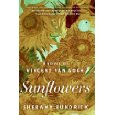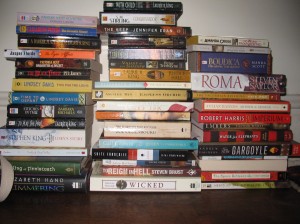In Publisher’s Marketplace:
Dutch rights to Alison Pick’s THURSDAY’S CHILD, to Orlando, at auction, by Margaret Halton at Rogers, Coleridge & White, on behalf of Anne McDermid at Anne McDermid & Associates.
Congratulations, Alison!

Reading and Writing History and Fiction (and sometimes food)
In Publisher’s Marketplace:
Dutch rights to Alison Pick’s THURSDAY’S CHILD, to Orlando, at auction, by Margaret Halton at Rogers, Coleridge & White, on behalf of Anne McDermid at Anne McDermid & Associates.
Congratulations, Alison!
 I am breaking my long blog silence (permanently — there will be many more posts in the next few days and weeks) for a very good cause, to celebrate the release today of Sheramy Bundrick’s debut novel, Sunflowers, published by Avon, about the story of Vincent van Gogh. I met Sheramy at the Historical Novel Society conference in June, and have been eagerly awaiting for this release.
I am breaking my long blog silence (permanently — there will be many more posts in the next few days and weeks) for a very good cause, to celebrate the release today of Sheramy Bundrick’s debut novel, Sunflowers, published by Avon, about the story of Vincent van Gogh. I met Sheramy at the Historical Novel Society conference in June, and have been eagerly awaiting for this release.
You can go here to enter a contest to win a copy of Sheramy’s book. Julianne has a review of the novel up there on her site today as well.
Spotted today in Publisher’s Marketplace:
Alison Pick’s THURSDAY’S CHILD, a story about love, hope and betrayal within an affluent Jewish family in Prague during the lead-up to Hitler’s invasion of Czechoslovakia, to Lynn Henry of House of Anansi, in a pre-empt, by Anne McDermid Associates.
That’s my cousin! Check out her website in my links. I’ve read this novel and it is wonderful. There are many novels about the war and the Holocaust, but this one is very different, about a place and a moment that is seldom described. To me, she gets the feel of Czechoslovakia as it fell to Hitler absolutely perfectly and the story is gripping and beautifully written. Her publisher is going to be very happy they picked up this book.
Maybe I’ll do a blog interview of Alison when her book is released. Hmm. *plots*
Amy Kelly’s engaging and evocative biography of Eleanor of Aquitaine, Eleanor of Aquitaine and the Four Kings says about Eleanor’s participation in the Second Crusade, citing Michaud’s History of the Crusades as her source:
With the queen came “many other ladies of quality,” Sybille , Countess of Flanders, whose half brother was King of Jerusalem, Mamille of Roucy, Florine of Bourgogne, Torqueri of Bouillon, Faydide of Toulouse, and scores of others whom the chroniclers could not afford the parchment to enumerate.
Do a google search for a few of those names. Go ahead, I’ll wait. You’ll find that scores of other writers, both in published non-fiction and fiction, as well as web-based sources have taken those words as gospel truth and have published that list of names almost word for word — Allison Weir, Norman Cantor, Antonia Fraser, etc.
Problem. Not one name on that list actually accompanied Eleanor to the Holy Land — and as it happens, Michaud mentions none of them. Let’s take a look at them one by one:
So, frankly, shame on all these authors for simply accepting Kelly’s words as fact, especially the ones who claim to be writing non-fiction. But the lie has been repeated so many times, it has become a commonplace. Faced with that, what does the historical novelist do? Work the myth into the story — or change it?
Julianne Douglas is seeking some help with market research, and I’d like to know the answer too. She wants to know what makes people choose to buy the historical novels that they buy. Which factor plays the biggest role in causing you to part with your dollars to buy a historical novel written by a new author?
Hop on over to her blog and answer the poll question on the top right hand side. And if you can’t decide (or even if you can) and want to comment about these or other reasons for buying a book, I’d love to read your comments, either here or over there.
I’m posting this here because I know I have many non-novelists but fervent readers who read this blog. I would love to learn your views.
Thanks!
Julianne tagged me for the p. 56 meme. I’m supposed to pick the book closest to me and then post the fifth sentence, and a few more.
The book closest to me is actually the section of Livy’s Histories that deal with the Roman wars with Hannibal. It has a very nice elephant on the cover and page 56, sentence 5 begins:
From the Druentia, Hannibal advanced towards the Alps mainly through open country, and reached the foothills without encountering any opposition from the local tribes. The nature of the mountains was not, of course, unknown to his men by rumour and report — and rumour commonly exaggerates the truth; yet in this case all tales were eclipsed by the reality. The dreadful vision was now before their eyes: the towering peaks, the snow-clad pinnacles soaring to the sky, the rude huts clinging to the rocks, beasts and cattle shrivelled and parched with cold, the people with their wild and ragged hair, all nature, animate and inanimate, stiff with frost.
And then I’m supposed to go to the 56th page of the book I am working on and post the fifth sentence from there. This bit comes from the end of a chapter:
After some time she grew concerned. Surely she and Liisa should have reached the high street by now. She was certain she’d recognize it from the noise. She noticed a new smell, replacing the former stench of animal parts and hides. It was burnt wood, but not from a householder’s hearth fire, more like a whole building that had burnt down and had been left to sit in the weather for a long time, a big building from the magnitude of the odour. If she had passed it on her way to the shop, she knew she would have noticed it before. There was no question about it, she was lost.
And now I tag five people:
Dr. B. who can do it when she gets back.
and
Can I create a meme? Let’s see. As you can see from my last post but one, there has been talk all over the internet about buying books as presents this Christmas. But what books to buy? I thought it would be fun to list ten books I read this year and describe why I liked them to give other people inspiration about things they may not have read. The only thing is, I realized that I have already written about many of the new books I loved this year. I picked ten books I hadn’t written too much about, just to make it interesting, but some of my favourites have already been reviewed. So check out the archives too for ideas.
And I tag — EVERYONE! List ten of your favourite new books in your blog or in the comments (or however many you can come up with). They don’t have to be new this year, just new to you this year. Here are mine:
Anthony Powell, Dance to the Music of Time. This is a link to the first of four volumes in this monumental series. I can’t beieve I had never read this before. Perfect for people who like novels about decayed upper classes in England between the wars.
Sarah Dunant, The Birth of Venus I liked this almost as much as In the Company of the Courtesan. About painters in Renaissance Florence in the time of Savonarola, if you like juicy but realistic historical fiction, this is for you.
Rebecca Stott, Ghostwalk. Nicely spooky, this blends animal rights activism with Isaac Newton and makes perfect sense.
Charles de Lint, Memory and Dream. Have I ever put up a list of books that didn’t have a de Lint book on it? This is another novel about an artist that threads together past and present perfectly.
Guy Gavriel Kay, Ysabel. Photography, magic, myth, Gauls and Romans, this is perfect or fantasy-loving adolescent. Or a fantasy-loving adult.
Gail Godwin, Father Melancholy’s Daughter. I love all her books, but I am especially partial to novels about angsty Anglicans and this is a perfect example of that genre.
Mohja Kahf, The Girl in the Tangerine Scarf. A novel about growing up Muslim in Indiana, beautifully written and rich with the textures and varieties of religious life.
Barbara Kingsolver, The Bean Trees. One of the good things about this book for the would-be writer is that it is wonderful, like all of hers, but it was her first published novel and you can see how she improved in her later work. It is encouraging.
Shirley Hazzard, The Great Fire. This is romance novel set in Japan, Hong Kong, and New Zealand in the aftermath of World War II. No, not a love story, a real romance novel. See for yourself. Who says literary fiction and romance are incompatible? Not me.
Steven Brust, Brokedown Palace. A fairy tale with all the requisite elements set in a magical, strange not-quite-but-almost-Hungary.
Okay, that’s ten. Now it’s your turn. Spread, little meme, and prosper, and may the authors you introduce prosper likewise!
 My books, let me show you them (click for a bigger view). This weekend was the annual used book sale in my neighbourhood, and I scored big. Every single one of these books for…$36.
My books, let me show you them (click for a bigger view). This weekend was the annual used book sale in my neighbourhood, and I scored big. Every single one of these books for…$36.
I do feel a bit guilty whenever I buy used books because I know the author isn’t benefitting from my purchase. But I look at it this way: I buy all kinds of books at this sale cheap, on a whim, and this introduces me to new authors I would never explore otherwise. An author I read in a used book one year may become an author I buy new in hardcover the next.
Besides, the vast majority of what I buy looks like it has been read once, if at all. By providing a secondary market for people who don’t like to keep the books they buy once they have read them (I do not understand these people, but anyway), I help free up all kinds of shelf space for them to buy new books. My hunch is that the more people reading books from any source — a shiny bookstore, a used book sale, or the library — the more authors will benefit in the end.